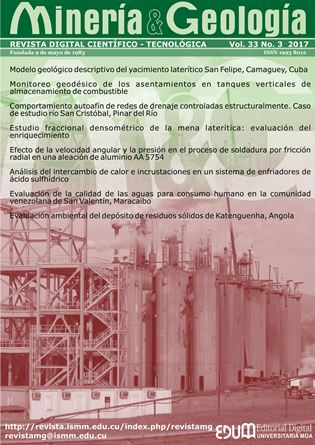Effect of angular velocity and pressure in radial friction welding of AA 5754 aluminum alloy
Keywords:
welding, rotational friction, transformation of phases, micro-structure, precipitates, AA 5754 alloy.Abstract
The objective of this investigation is to determine the relation between the transformations of phases occurring during the rotational friction welding of AA 5754 12-mm-diameter aluminum alloys. The process was carried out using a 16 K 20 lathe based on joint parameters ranging between 1 200 and 1 400 rev/min with a pressure of 0,9 and 1,9 MPa, respectively. It was determined that the friction temperature decreases as the number of revolutions increases as well as the metallurgical variation both in the thermo-mechanically affected area and in the thermally affected area. The hardness profiles show the increase by the plastic flow effect, metallurgical variations and the existence of precipitates.Downloads
References
COLLIGAN, K.; MISHRA, R. 2008: A conceptual model for the process variables related to heat generation in friction stir welding of aluminum. Scripta Materialia. 58(5): 327-331.
ENGLER, O. 2014: Texture and anisotropy in the Al-Mg alloy AA 5005-Part I: Texture evolution during rolling and recrystallization. Materials Science and Engineering. A (618): 654-662.
FALLA, R.; QUINTANA, K.; FRANCO, F.; SÁNCHEZ, N. 2012: Propiedades mecánicas de soldadura por fricción agitación de punto en aleación de aluminio AA6063-T5. Prospect. 10 (1): 79-84.
LONGHURST, A. 2010: Torque control of friction stir welding for manufacturing and automation". Int J Adv Manuf Technol. 12 (5): 905-913.
MISHRA, R.; MAHONEY, M. 2007: Friction Stir Welding and Processing. Ohio: ASM International. p. 333.
OOSTERKAMP, A.; OOSTERKAMP, L.; NORDEIDE, A. 2004: Kissing bond' phenomena in solid-state welds of aluminum alloys. Welding Journa, 83 (8): 225-S.
PEEL, M.; STEUWER, A.; PREUSS, M.; WITHERS, P. 2003: Microstructure, mechanical properties and residual stresses as a function of welding speed in aluminium AA5083 friction stir welds. Acta Materialia. 51(16): 4791-4801.
SESHAGIRIRAO, B.; SIVARAMAKRISHNA, V.; SAIKRISHNAPRASAD, G. 2015: Experimental Investigation of Rotary Friction Welding Parameters of Aluminum (H-30) and Mild Steel (AISI-1040). International Journal of Innovative Research in Science, Engineering and Technology. 4(5): 2920-2925.
TOKAJI, K.; UEMATSU, Y. 2009. Comparison of fatigue behavior between resistance spot and friction stir spot welded aluminum alloy sheets. Science and Technology of Welding and Joining 14(1): 62-68.
TRA, T.; SEINO, M.; SAKAGUCHI. M.; OKAZAKI, M. 2010: Fatigue crack propagation behavior relevant to inhomogeneous microstructure of friction stir welding AA6063-T5. Journal of solid mechanics and materials engineering 4(6): 840-848.
WEGLOWSKI, A. 2011. Friction stir processing - analysis of the process. Archives of metallurgy and materials 56 (11): 779-788.
ZIMMER, S.; LANGLOIS, L.; LAYE, J.; BIGOT, R. 2010. Experimental investigation of the influence of the FSW plunge processing parameters on the maximum generated force and torque. International Journal of Advanced Manufacturing Technology 47(1-4): 201-215.
Published
How to Cite
Issue
Section
Copyright (c) 2017 Elís Efraín Guzmán-Romero, Tomás Hernaldo Fernández Columbié, Dayanis Alcántara-Borges, Isnel Rodríguez-González

This work is licensed under a Creative Commons Attribution-NonCommercial 4.0 International License.
- Authors retain copyright and guaranteeing the right magazine to be the first publication of the work as licensed under a Creative Commons Attribution-NonCommercial that allows others to share the work with an acknowledgment of the work's authorship and initial publication in this journal.
- Authors may establish separate supplemental agreements for the exclusive distribution version of the work published in the journal (eg, place it in an institutional repository or publish it in a book), with an acknowledgment of its initial publication in this journal.
- Authors are allowed and recommended to disseminate their work through the Internet (e.g., in institutional telematic archives or on their websites) before and during the submission process, which can produce interesting exchanges and increase citations of the published work. (See The effect of open access)










